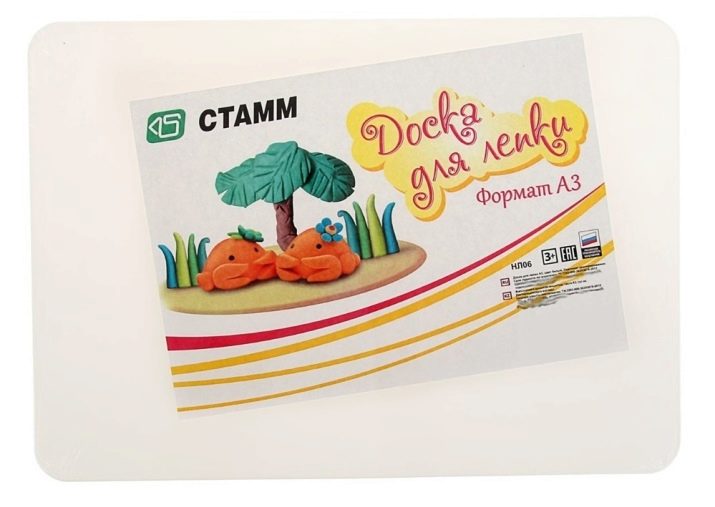Features of boards for modeling

The modern market for baby products is full of a variety of games and activities that are aimed at developing a child's creative skills. One of these is plasticine, in the process of sculpting, fine motor skills develop, creativity and imagination are formed.
In order to make working with plasticine more convenient, special boards for modeling were created, on which the child does all the work to create his "masterpiece".

What is it and why are they needed?
The sculpting board allows you to create a work area for your little one, making the activity more comfortable. This device creates more convenient conditions for doing various actions with plasticine (rolling, cutting, molding, etc.). In addition, a limited work space teaches the child to do what he loves in a certain place, teaches him to be clean and tidy.

The features of the sculpting board are as follows:
- it is a limited work area that teaches the child to do business in one place;
- it is easily cleaned of the remnants of plasticine, while the surface of the table remains clean (at least most of it);
- ideal for practice with clay, wax, dough and kinetic sand.

Such a board is recommended to be purchased in kindergartens and schools, as it teaches the child to keep the workplace clean.
Species overview
Modern sculpting boards are represented by a large number of various models, differing in size, shape, color, as well as the presence of additional elements.



We suggest that you familiarize yourself with the models of sculpting boards from the most popular manufacturers.
- Working surface for sculpting "Stamm" made of hard plastic (Russia). Size - A3, thickness - 2 mm.large white rectangular work surface for working with plasticine, dough, clay. Has safe "soft" corners.

- Set for modeling No1 School of Shustriki (Belarus). The kit includes a board and two stacks. Children's model in green, A4 size and 3 mm thick. "Soft" corners, hard plastic - safe and durable.

- Modeling board with a relief stencil (Russia). Size - A4. A white plastic rug on one side is covered with a smooth surface on which no plasticine remains. From the reverse side it looks like a three-dimensional drawing.

- Modeling board Silwerhof (Russia)... The product is white in size A5, thickness is 1 mm. The plastic model with rounded edges is a safe option for children under 3 years of age. They come in a variety of colors and sizes.

- Board "Yunlandiya" (Russia). The working area is blue for practicing with plasticine, clay, A4 size dough. Provides 7 compartments for plasticine, also in the set there are 2 stacks of different shapes.

Criterias of choice
In order for the child to enjoy sculpting various figures from plasticine or dough, it is necessary to prepare a comfortable workspace for him and choose the right board.

Here are some guidelines to help you with this.
- Boards are produced in two types: plastic and wooden... The first are the most common, they come in different design options and are presented in a wide palette of colors. Such products are cheaper than wooden models, and are much more practical to maintain and operate. However, if it is important for you that your child only works with environmentally friendly material, you should give preference to a wooden sculpting board. Finding such a device is not easy. Some people use as a sculpting board an ordinary cutting board made of wood, which we are used to using in the kitchen.
- The sizes of the boards are of several types - A5, A4 and A3. For practicing at home, it is better to choose the largest of all options. It is more convenient to work on such one, and it is less likely that the clay will fall outside the board.
- When choosing a color, it is preferable to buy models of light colors.... The baby's eyes get tired quickly when working on a bright-colored board, especially red.
- There are plain and patterned boards.... If it is important for you that the child is focused on sculpting the figurine, it is better to choose monochromatic models so that he is not distracted. However, on boards with a picture, it will be more interesting for a kid to play with a finished craft.
- There are double-sided products... One side of which is intended for sculpting, and on the other there is one or more small relief images. It is used to transfer an image drawn with wax crayons onto a sheet of paper.


How to clean after work?
After the baby has finished working on creating crafts from plasticine, mothers will have a difficult task of cleaning the workspace.
First you need to remove the remnants of plasticine with an ordinary scraper. You will not be able to completely clean the work surface, but it will make it easier to clean it later.

There are three main ways to clean your sculpting board well.
- Hot water. Any plasticine can be easily cleaned under the influence of high temperature water. The disadvantage of this method is that not all plastic boards normally tolerate contact with boiling water, they can deform or crack.
- Vegetable oil. Wipe the dirty surface with a cotton pad or cloth soaked in vegetable oil. Then wash the clean board with a regular dishwashing detergent to get rid of the greasy residue.
- Toilet paper or tissue paper... We form a lump from the napkin and pass it along the surface with plasticine, which remains on the napkin. This cleaning option will take the longest, but it has no consequences.

See below for instructions on how to clean your board.








